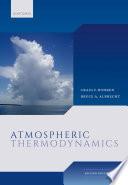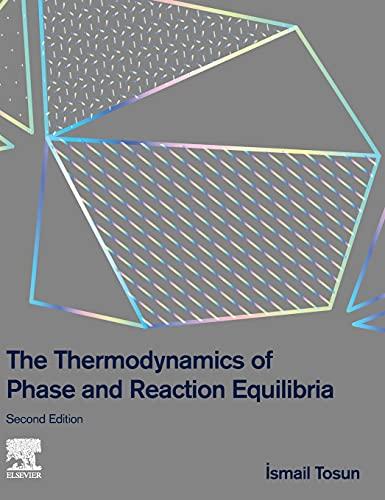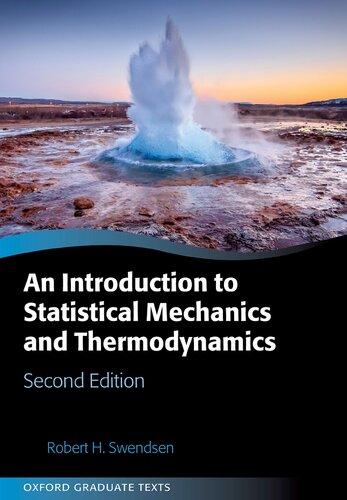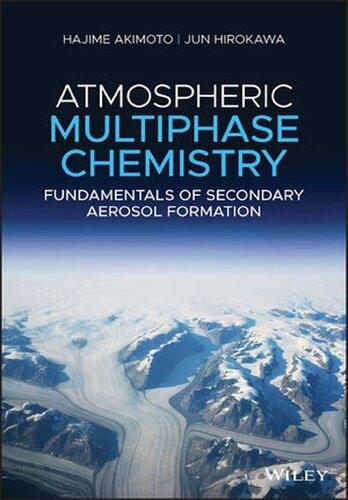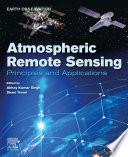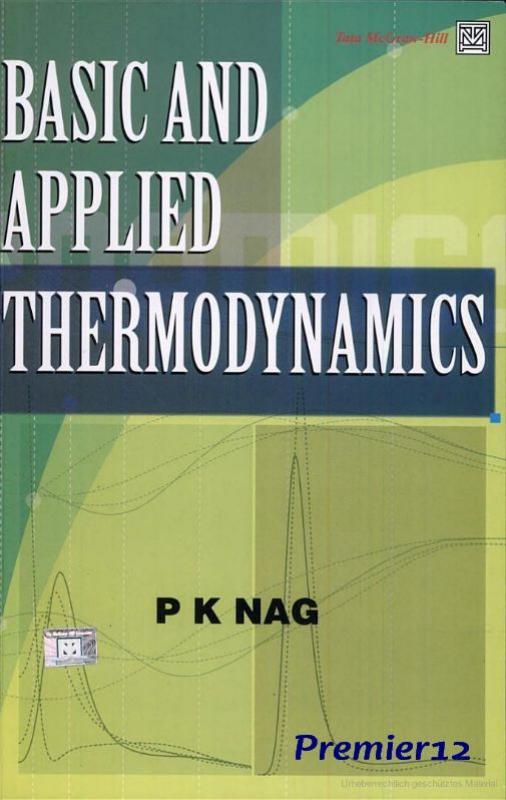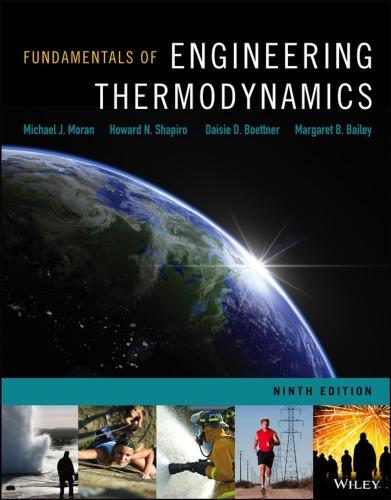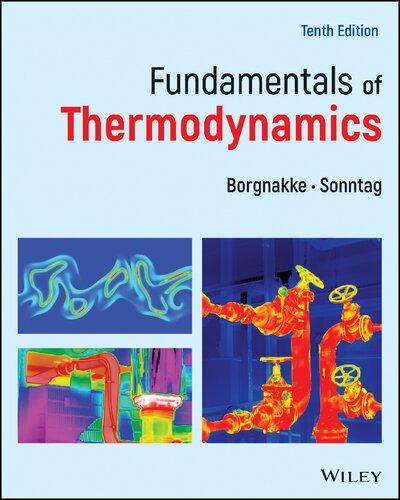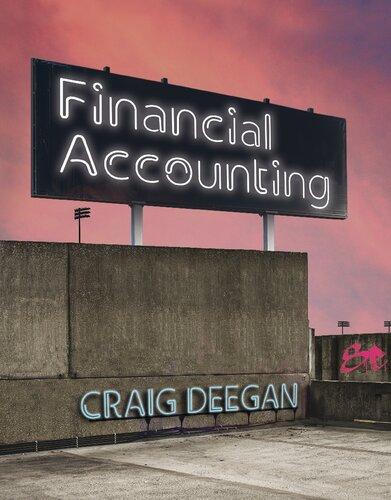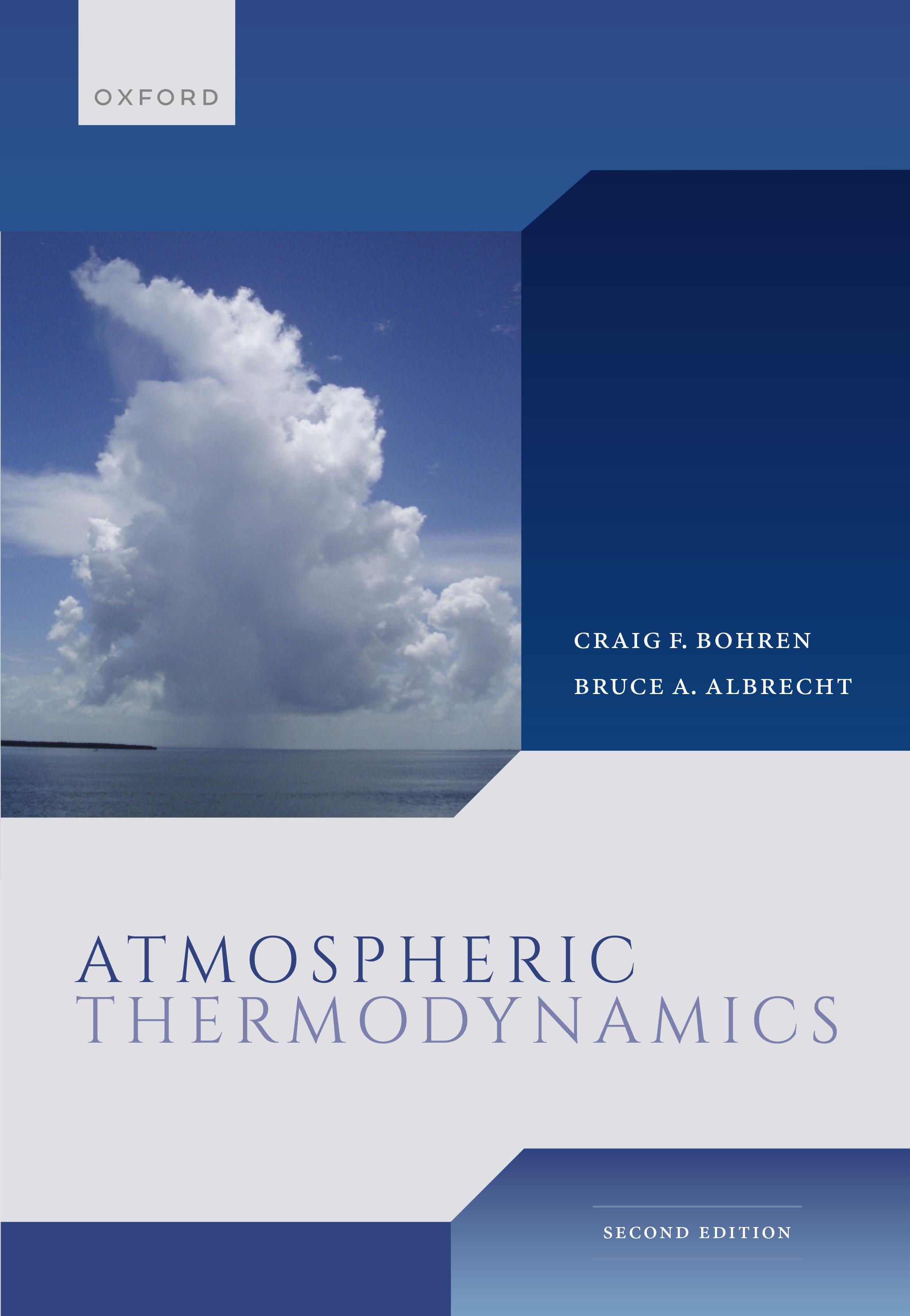Atmospheric Thermodynamics, 2nd Edition Craig Bohren Visit to download the full and correct content document: https://ebookmass.com/product/atmospheric-thermodynamics-2nd-edition-craig-bohre n/
More products digital (pdf, epub, mobi) instant download maybe you interests ...
Modern Thermodynamics for Chemists and Biochemists 2nd Edition Dennis Sherwood
https://ebookmass.com/product/modern-thermodynamics-for-chemistsand-biochemists-2nd-edition-dennis-sherwood/
The Thermodynamics of Phase and Reaction Equilibria 2nd Edition Ismail Tosun
https://ebookmass.com/product/the-thermodynamics-of-phase-andreaction-equilibria-2nd-edition-ismail-tosun/
An Introduction to Statistical Mechanics and Thermodynamics 2nd Edition Robert H. Swendsen
https://ebookmass.com/product/an-introduction-to-statisticalmechanics-and-thermodynamics-2nd-edition-robert-h-swendsen/
Atmospheric Multiphase Reaction Chemistry 1st Edition Hajime Akimoto
https://ebookmass.com/product/atmospheric-multiphase-reactionchemistry-1st-edition-hajime-akimoto/
Atmospheric Remote Sensing Abhay Kumar Singh
https://ebookmass.com/product/atmospheric-remote-sensing-abhaykumar-singh/
Engineering Thermodynamics P.K. Nag
https://ebookmass.com/product/engineering-thermodynamics-p-k-nag/
Fundamentals of Engineering Thermodynamics 9th Edition
eBook
https://ebookmass.com/product/fundamentals-of-engineeringthermodynamics-9th-edition-ebook/
Fundamentals of Thermodynamics 10th Edition Claus Borgnakke
https://ebookmass.com/product/fundamentals-ofthermodynamics-10th-edition-claus-borgnakke/
Financial Accounting, 8th Edition Craig Deegan
https://ebookmass.com/product/financial-accounting-8th-editioncraig-deegan/
AtmosphericThermodynamics AtmosphericThermodynamics SecondEdition CraigF.Bohren
DepartmentofMeteorologyandAtmosphericScience,PennsylvaniaStateUniversity
BruceA.Albrecht DepartmentofAtmosphericSciences,UniversityofMiami
GreatClarendonStreet,Oxford,OX26DP, UnitedKingdom
OxfordUniversityPressisadepartmentoftheUniversityofOxford. ItfurtherstheUniversity’sobjectiveofexcellenceinresearch,scholarship, andeducationbypublishingworldwide.Oxfordisaregisteredtrademarkof OxfordUniversityPressintheUKandincertainothercountries
c ⃝ CraigBohrenandBruceAlbrecht2023
Themoralrightsoftheauthorshavebeenasserted FirstEditionpublishedin1998 SecondEditionpublishedin2023
Allrightsreserved.Nopartofthispublicationmaybereproduced,storedin aretrievalsystem,ortransmitted,inanyformorbyanymeans,withoutthe priorpermissioninwritingofOxfordUniversityPress,orasexpresslypermitted bylaw,bylicenceorundertermsagreedwiththeappropriatereprographics rightsorganization.Enquiriesconcerningreproductionoutsidethescopeofthe aboveshouldbesenttotheRightsDepartment,OxfordUniversityPress,atthe addressabove
Youmustnotcirculatethisworkinanyotherform andyoumustimposethissameconditiononanyacquirer
PublishedintheUnitedStatesofAmericabyOxfordUniversityPress 198MadisonAvenue,NewYork,NY10016,UnitedStatesofAmerica BritishLibraryCataloguinginPublicationData Dataavailable
LibraryofCongressControlNumber:2022946525
ISBN978–0–19–887270–2 ISBN978–0–19–887271–9(pbk.) DOI:10.1093/oso/9780198872702.001.0001
Printedandboundby CPIGroup(UK)Ltd,Croydon,CR04YY
Linkstothird-partywebsitesareprovidedbyOxfordingoodfaithand forinformationonly.Oxforddisclaimsanyresponsibilityforthematerials containedinanythirdpartywebsitereferencedinthiswork.
ToourfamiliesNanette,Gail,Birch,andSpritz;Nancy,Michael,andAdam
PrefacetoSecondEdition Thefirsteditionofourbookisawell-regardedtreatiseonatmosphericthermodynamics,asevidencedbythemanytimesithasbeencited.Althoughintendedas atextbookinatmosphericscience,itcouldbeusedasareferenceortextbookfor classicalthermodynamicstaughtinphysicsorengineeringdepartments.Itbrings real-lifeproblemsandapplicationstoasubjectthatotherwisecanbesomewhat dry.Earth’satmosphereisafreelyaccessiblethermodynamicslaboratoryinwhich wealllive.Manyofourexperimentsweredoneinkitchensandonporchesusing inexpensiveinstruments.
Theimpetusforasecondeditionwastolowerthepricetowhatstudentscan afford.Italsoallowedustocorrecterrorsandpassonwhatwehavelearnedinthe 24yearssincethefirstedition.Wedidn’tstopthinkingafteritwaspublished.We useditasatemplatebutrethoughteverysentence.Weremovedasubsectionthat wasjustplainwrong,althoughaboutasideissue(phew!).Afewsubsectionswere removed,afewadded.Minorerrorswerecorrected.
Wetookmorepainstostateallassumptions,idealizations,andapproximations notablyabsentfromtextbooks.Energyisconserved,entropyincreases(probably), buteverythingelseiscontingent.Werearranged Chapters3 and 4 Chapter7 was expandedtoincludemoreabouttheinteractionofhumanswiththeirenvironment. Wediscussmoreaboutwhatcouldbecalledengineeringheattransfer—asubject unknowntomanyphysicistsandmeteorologists.Wheneverpossiblewedidsimple experimentsandmadeobservationstosupportourassertions.Weputconsiderable effortintomakingexplanationsimpossibletomisunderstand,anunattainablegoal butworthaimingat.Wedoubledthenumberofproblemstomorethan400.They arosefromquestionsweaskedourselvesorwereaskedbystudents,colleagues,and correspondents.Weprofitedfromansweringthem.Weincludedmoresuggestions forexperimentsandobservations.Someoftheseexperimentsweredonebyour eminentpredecessorsmorethan200yearsago.Inthefirstedition,wecriticized textbookhistory.Aftermanyyearsofreadingandreflecting,weareevenmore convincedthattherearefewhistoricallycorrectstatementsintextbooks.Askany historianofscience.Textbooksarenotmuchinfluencedbyoriginalpapers,ones criticizingtextbookmythology,orpapersbyhistoriansofscience.Wereadmany booksandpapersby,forexample,Gay-Lussac,Fourier,JosephBlack,Joule,Robert Boyle,andothers.Notonlydidthisallowustogivecreditwhereitisdue,butalso weacquiredphysicalunderstandingandintuitionfromthethoughtsoflong-dead authors.Wegivemorereferencesthanisthenormintextbookstosupportwhat wewrite,ratherthanuncriticallypassonerrors.Ourreferencesarenotwindow
PrefacetoSecondEdition vii dressing.Wereadthepaperswecite,sometimesentirebooksoratleastrelevant chapters,andtooknotesonthem.Failuretocitereferences,evenintextbooks, contributestoerrorpropagation.Weaddedabout150referencestobringourbook uptodateandbecausewehappeneduponmanybooksandpapersworthreading.
Becauseofourinterestinthehistoryofscience,wecallattentiontoafairly recentjournal, HistoryofMeteorology,whichatpresentisfreelyavailable.
Therearemanylong-liveddemonstrablyincorrectexplanationsinmeteorology. Theyoriginateinelementaryandmiddleschool,continueuncorrectedintohigh school,university,andbeyond.Wedomoredebunkingofsuchexplanations.AsH. L.Menckenwrote,“Ninetimesoutoften,intheartsasinlife,thereisactuallyno truthtobediscovered;thereisonlyerrortobeexposed.”
Weemphasizeevenmorethaninthefirsteditionphysicalreasoningandinterpretation,whicharemorelikelytostickinthemindsofstudentslongaftertheyhave forgottenequations.Asthebookrevieweditorof AmericanJournalofPhysics for abouteightyears,theseniorauthorhasseenmanybooksthatareonlyoneequation afteranother.Nointerpretation,noexperiments,noobservations,noconnectionto reality.
Weareheartenedthathereticalideasinthefirsteditionhavesubsequentlybeen madebyothers.RobertRomer,aseditorof AmericanJournalofPhysics,wrote ascathingeditorial“Heatisnotanoun”inwhichhecitesus.Fierceandprolongedcriticismofthenotionthat“entropyisjustdisorder”bythelatechemist FrankLambertinthelast20yearsofhislonglifegoadedchemistsintoremoving thismantrafromchemistrytextbooks.ItalsohasbeenattackedbyHarveyLeff inphysicsjournals.Manyphysicalchemistsnolongerreferto“heats”ofvaporizationorcombustion,butinsteadtoenthalpies(asinourfirstedition),another signofprogress.Merelybecausewecanfindotherwiserespectableteachersand authorswhoshareourviewsdoesnotmeanthatweareright—onlythatweare notlonecrackpots.Wecorrectederrorsonlyifwefoundtheminseveraltextbooks orpopularizations,especiallyiftheyhavebeenmadeoverdecades.Formanyyears, the JournalofChemicalEducation hadaregularcolumn,“TextbookErrors,”the purposeofwhichwastohaltthespreadofdemonstrableerrors.Foranerrortobe exposedithadtooccurin“atleasttwoindependentstandardtexts,”whichwere notcited.
Sectionsandsubsectionsmarkedwithanasterisk(*)canbeomittedonafirst readingofthetext.
Weupdatedourdiscussionofinstrumentsformeasuringtemperature,dewpoint, humidity,andpressure.Inthepasttwodecadesinstrumentshavegottenbetterand cheaper.Infraredthermometersareinexpensive.Studentscan(andshould)dotheir ownexperimentsandmakeobservationssothattheyownthem.“Whatyouinherit fromyourfathermustfirstbeearnedbeforeitisyours”(Goethe).
Followingthetextofeachchapterisalistofannotatedreferences.Eachentry containstidbitsthatcouldhavebeeninthetext.Readthemtogetthemaximum benefitfromthisbookevenifyoudonotreadthereferencescited.Workasmany oftheproblemsaspossible,especiallythoserequiringsimpleexperiments.
Underlyingalllawsofphysics(tobedistinguishedfromlawsofnature)are agreatmanyassumptionsandidealizations,oftenunstated.Criticsofthespace we“waste”onbelaboringwhat“everyoneknows”shouldreadthefirsteverguest editorialin EuropeanJournalofPhysics,Vol.40(2019)030201.Itbegins“Amajor challenge[to] impartingwhatateacherknowstostudentswhodonotknowis overcomingthecurseofknowledge.”
ThelateCliffordTruesdell,aprolifichistorianofthermodynamicsandcontributortorationalthermodynamics,wrotein1969that“fromthefirstthermodynamics wasadismalswampofobscurity”andtoday“incommoninstructionit[still]is.” Thisbookisourcontributiontodrainingtheswamp.
Acknowledgments Firstandforemost,weareindebtedtoBertdeWithforbeingtheonlyreader towritetousaboutablatanterror,therebysavinguspossiblefurtherembarrassment.DanSchroedercriticizedourtreatmentofthetemperaturedependenceofthe enthalpyofvaporization.Westillgotthetextbookresult(Kirchhoff’sequation), butnowweunderstanditbetter,whyitisagoodapproximation(withinlimits), andwhyitis not sogoodfortheenthalpyoffusion.RogerDaviessuggestedthatthe decreaseofdownwardinfraredradiationwithincreasingaltitudecouldcontribute tosensationsofcoldathighaltitudes.PeterPilewskieencouragedBruceKindelto doradiationcalculationstosupportthis(Chapter7).RaymondShawkeptusfrom makingblundersaboutturbulenceandhomogeneousnucleation,andalsopassedon someofAlexKostinski’smusingsabouttheusual(superficial)physicalexplanation ofwhy Cp >Cv ShermilaSinghamstraightenedusoutontheArrheniusequation. GregoryMcRaeencouragedustoconvertalmostallourunitstoSIandsharedwith ushisfascinationwithindicatordiagrams.SharanMajumdarspottedmanytypographicalerrorsandaskedforclarification.JohnKennyencouragedustonotethe hugedifferenceinthereactiontimesofcombustionofhydrogeninoxygen,afactor ofabout1031 withandwithoutacatalyst.Fromtimetotime,weaskedBobHummerquestionsaboutwetchemistryandtriedoutideasonhim.Conversationswith JamesFlemingcontinuetopiqueourinterestinthehistoryofmeteorology.Despite ourbruisesfromwrestlingwithGlennShawoverthecoefficientofperformanceof arefrigerator,weemergedwithabetterunderstandingofwhatisadmittedlya confusingconcept.WealsothankShaneMayorforcorrespondenceaboutvarious aspectsofthermodynamics,LeeGrenciformanydiscussionsaboutmisconceptions heheroicallytriestodispel,andJohnWyngaardforpreventingusfrompassingon thewidespreadbutfaultyphysicalinterpretationoftheGrashofnumber.Finally, weareindebtedtoSonkeAdlungforenthusiasticeditorialsupport.
CraigF.Bohren Tˆy’nyCoed OakHall,Pennsylvania
BruceA.Albrecht St.Petersburg,Florida
March2022
PrefacetotheFirstEdition In TheEndofEducation (p.115),NeilPostmanassertsthat“Wecanimprovethe qualityofteachingandlearningovernightbygettingridofalltextbooks.Mosttextbooksarebadlywrittenand,therefore,givetheimpressionthattheyareboring. Mosttextbooksarealsoimpersonallywritten.They revealnohumanpersonality.”ThiswillnotendearPostmantotheauthorsoftextbooks,but,sadtosay, hetellsthetruth,unpalatablethoughitmaybe.Whenconfrontedwithsearing criticismlikethis,howwillbuddingtextbookauthorsreact?Whichpathwillthey take:denial,orintrospectionandreform?
Wewrotethisbookinspiredbythehighlyradicalnotionthattextbooksought toberollickinggoodliteraturegiventhattheirintendedreadersaremostlyyoung people,thosethroughwhomthejuicesoflifeflowstrongest,andhence,thosemost repelledbydryandlifelesstextbookfodder.Thisnotionisradicalbecausetheprevailingviewoftextbooksisthattheyshouldbeasboringaspossible.Writtenin thepassivevoice,humorless,withoutawhiffofcontroversy,textbooksarepainstakinglypurgedofanyhumantouch.Theyseemtobewrittenwiththeaimofmaking scienceasuninterestingaspossiblesothattheirauthorscanthenwringtheirhands overthelackofinterestshownbyyoungpeopleinscience.
Wetriedtomakeourwritingaslivelyaspossiblebyusingactiveconstructions andbynothidingthefactthatwearehumansfirst,scientistssecond.Wedonot shrinkfromcriticizingfallacies,nomatterhowhallowedbyfrequentrepetition.We usehumor,irony,andsarcasm,allthetechniquesofthewritingtrade,tokeepour readersinterested.Afterall,theyaremostlyyoungpeoplewhoarebombardedcontinuallybystrikingvisualimagesandvividentertainmentinmanyforms.Today’s audiencefortextbooksisthemostdistractedandtheleastattentiveinthehistory ofliteratehumanity.
Oneofthemostdepressingfeaturesoftextbooks,asidefromtheirblandness,is theirmonotonoussameness.Anoriginaltextbookisalmostacontradictioninterms. Thermodynamicsprovidessomeprimeexamples.Everythermodynamicstextbook findsitnecessarytoincludeaponderoussectionbelaboringexactandinexactdifferentials,whichstudentsdonotunderstandandwhich,moreover,areunnecessary. Thelate,eminentmathematicianKarlMengeralmosthalfacenturyagogently pointedoutthatdifferentialsofanykindareunnecessaryinteachingthermodynamics.Toourknowledge,nosubsequentauthorofatextbookonthermodynamics haspaidanyheedtoMenger.CliffordTruesdell,anastutestudentofthefoundationsandhistoryofthermodynamics,dipshispeninthemostcorrosiveacidwhen writingaboutdifferentialsinthermodynamics.Evenmathematiciansviewthem
withdisdain.Yet,differentialscontinuetoappearinthermodynamicswithdepressingregularity.Themathematicsofthermodynamicsisreallyquitesimple,child’s playcomparedwiththatof,say,electromagnetictheoryandfluidmechanics.To compensateforthis,themathematicalnotationinthermodynamicsseemstohave beenspeciallydesignedtobeconfusing,tocreatetheimpressionthatitisthework ofMartians.
Nobook,especiallyoneaboutsohoaryatopicasthermodynamics,shouldbe writtenexceptbythosewhoimmodestlythinkthattheycandobetterthantheir predecessorsandwhoarewillingtomakeafreshstartinsteadofmerelyrearranging whathasbeendonepreviously.Thisgoalislikelytobereachedonlyifauthorsare awareoftheailmentsofexistingbooksandcanproposecuresfortheseailments.
Toavoidcommittingthesinsofourpredecessors,wewereguidedbytheaccumulatedwisdominarticlesonthermodynamicsandrelatedtopicspublishedin AmericanJournalofPhysics fromitsinceptionabout60yearsagotothepresent. Thisjournalisdevotedtoexpositoryarticlesonphysicswrittenmostlybycollege anduniversityteachers.Itisapedagogicalgoldmine,yetnotusedtoitsfullest extentbywritersoftextbooks.Beforewewerecontentwithawayofdiscussinga concept,wecarefullyponderedtherecommendationsofthosewhohavethoughtlong andhardabouthowthermodynamicsshouldbetaught.Othersourcesoffruitful ideasare JournalofChemicalEducation, ThePhysicsTeacher, EuropeanJournal ofPhysics, PhysicsEducation, AmericanMathematicalMonthly,and ContemporaryPhysics.Giventhetreasuretroveofthoughtfulandcriticalexpositoryarticles, mostofthemhighlyreadable,inthesejournals,therubbishthatcontinuestobe propagatedintextbooksisinexcusable.Weonlywishthatwehadhadmoretime totakeadvantageofthishugebutlargelyuntappedreservoirofideas.
Whatdistinguishesatextbookfromatechnicalmonographisproblemsinthe formerbutnotinthelatter.Andwhatdistinguishesthermodynamicstextbooksis problemsevenmoreboringthanthetextthatprecedesthem.Atypicalproblem issomethinglikethefollowing:“Whatisthefinaltemperatureoftwokilogramsof nitrogeninitiallyatroomtemperaturewhenitspressureisdoubledadiabatically?” Thisisthekindofdrillquestionrarely(ifever)askedoutsidethepagesoftextbooks, aquestiontowhichnoonewantstoknowtheanswer,whatstudentsreferto contemptuouslyas“plugandchug.”Yet,questionsintextbooksshouldbegenuine, bywhichwemeanonesthatinquisitivepeopleaskinthecourseoftheirattemptsto understandtheworldaroundthem.Anexampleofagenuinequestionisonewewere askedbyawriterforamotorcyclemagazine.Hecalledtoaskaboutwindchill.Our responsewasdulypublishedinthemagazine.Aquestionaboutthermodynamics askedbytattooedandbeardedmenwearingnoseringsandridingchrome-plated Harley-Davidsonmotorcyclesisbyourreckoningagoodquestion.
Themorethan200problemsinthisbookarenotoptional,tackedontotheend ofchaptersasafterthoughts,butmandatory.Yetwelookuponthemasrewards,not punishments.Thepayoffforstrugglingwithideasisthesatisfactionacquiredfrom usingthem.Problemsprovideanopportunityforreaderstotestwhattheyhave learned,togobeyondthetext,togeneratenewideas.Indeed,someproblemsare avehicleforpresentingtopicsthatcouldhavebeenincludedinthetext.Wehope
thatmostoftheseproblemsareinterestingtostudentscuriousabouthowtheworld works.Manyproblemswereinspiredbyquestionsaskedbycolleagues,students,and friends,Thermodynamicknowledgecanbeappliedtocountlessgenuineproblems. Thereisnoneedforcontrivedones.
Attheendofeachchapter,problemsaregiveninrandomorder,notarranged accordingtosection.Thiswasacompromisebetweenputtingallproblemsatthe endofthebookandgroupingthemaccordingtosection.Thedisadvantageofpairingproblemswithsectionsisthatitencouragesstudentstosearchfranticallyfor amagicformulainasectionthatwillenablethemtosolveacorrespondingproblem.Studentsshouldlearnthatknowledgeiscumulativeandthatsolvingphysical problemsrequiresdrawinguponresourcesfromdifferentdirections.
Althoughourintendedreadersareundergraduatestudents,weexpectthisbook tobesuitableforgraduatecoursesinatmosphericthermodynamics.Thisisespeciallytruegiventhatgraduatestudentsinatmosphericscienceoftenaredrawn fromphysics,mathematics,engineering,andothertechnicalfields.Thus,evenat thegraduatelevel,especiallyindepartmentswithoutundergraduateprograms,studentsaretaughtthesamematerialasinundergraduatecoursesbutatafasterpace andwithhigherexpectations.Sectionsandsubsectionsmarkedwithanasterisk(*) canbeomittedonafirstreadingofthetext.Allweexpectofourreadersinthe wayofprerequisitesisthattheybefirmlygroundedintheelementsofcalculus,at leastknowwhatadifferentialequationis,andarefamiliarwithvectors.Noprior knowledgeofthermodynamicsisassumed.Indeed,wewouldpreferreaderstobe innocentofthermodynamicssothattheyhavelesstounlearn.
Theboundariesbetweenscientificdisciplinesarenowastightlydrawnand fiercelydefendedastheboundarybetweenNorthandSouthKorea,yetwestill canhopethatteachersofphysicsandengineeringmightfindourbookauseful supplementintheircourses.
Itissometimessaidthatthermodynamicsismodelindependent,thatiftomorrowweweretodecidethatmoleculesdonotexist,theprinciplesofthermodynamics wouldnotneedtobealteredintheslightest.Thisistruebutlargelyirrelevant. Allcollegestudentstodayhaveatleastheardofmoleculesandcannotberestored totheirpreviousstateofblissfulignorance.Butwhatthesestudentshaveheard aboutmoleculesisoftenbilge.Forexample,wehaveyettoencounterastudent whodidnotferventlybelievethattheabsolutezerooftemperatureisthetemperatureatwhichallmoleculescomegrindingtoahalt.Thisisnottrueandhasbeen knownnottobetrueformanydecades.Meteorologywasspawnedfromphysics(or whatisnowphysicsbutusedtobenaturalphilosophy).Theparentandchildhave gonetheirseparateways,asaconsequenceofwhichwhatmeteorologistsaretaught issometimesludicrous.Asithappens,temperaturesintheatmospherenevereven approachabsolutezero;someteorologistscanentertainwildlyincorrectideasabout absolutezerowithnopracticalconsequences—exceptthattheymakethemselves outtobefoolsintheeyesofpeoplewhoknowbetter.
Thermodynamics,webelieve,tastesbestwhenspicedwithkinetictheory,and sowewovethreadsofthekinetictheoryofgasesintothefabricofclassicalthermodynamics.Althoughstudentscannotbepreventedfrominvokingmoleculesto
explainnaturalphenomena,theycanbetaughttomakemolecularargumentscorrectly.Moreover,invokingmoleculesdoesseemtogiveusabettergraspofphysical phenomena.Despiteallthecurrentblatheraboutholism,mostpeoplenaturally gravitatetowardreductionism.Althoughsometimescarriedtoextremes,whichhas givenitabadname,whenrestrainedbycommonsenseandprudence,reductionism isahighlyeffectivewayofacquiringunderstanding.
Wehavelearnedthroughexperiencethatourstudentsoftenlookuponderivationsofequationsasendsinthemselves.Weviewderivationsasmeans,theends ofwhicharephysicalinterpretations.Weforgetthedetailsofderivations,whichis notsurprisinggiventhattheyoftenaretedious.Theproductofaderivationisan equation,whichmustbeinterpretedphysically,anditsmeaningexpressedinwords: wethinkwithwords,notwithequations.Wheneverpossible,westateamathematicalresultinwordschosentostickinthemindsofreaders.Theywillforgetthe mathematicaldetails,butwecanhopethattheywillretaintheirphysicalessence.
Wetookpainstoderiveequationscarefully,exposingtotheclearlightofday allassumptionsandapproximations(weabhortheirritatingtextbookdodge,“it canbeshown”).Thisapproachisnotlikelytofindfavorwiththosewhojust wantformulastobechantedasmantraswhenfacedwithproblems.Althoughit wouldbeeconomicalofspacetopullequationsoutofthinair,ignoranceoftheir antecedentsisnotmerelyuseless;itisdangerous.Ifyoudon’tknowwhatunderlies anequation,youcan’tuseitcorrectly,norcanyoufixitwhenitbreaks.And virtuallyeveryequationinatmosphericthermodynamicsisanapproximationwith alimitedrangeofvalidity.Westronglyadheretotheviewthatstudentsshouldbe encouragedtomakeasmanyobservationsofatmosphericphenomenaaspossible andeventodosimpleexperiments.Oneofthegreatappealsofatmosphericscience isthatwealwaysareinitslaboratory.Accordingly,wesuggestsimpleexperiments andtrynottomissopportunitiestopointouthowlifecanbebreathedintoinert symbolsonthepagesofthisbook.Agoodexampleisprovidedbymixingclouds (Section 6.8).Tounderstandthesecloudsrequiresconservationofenthalpy(inan adiabaticconstant-pressureprocess)andtheClausius–Clapeyronequation,which itselfembodiesconsiderablethermodynamicreasoning.Itishighlyeffectivetolink theseperhapsinherentlyuninterestingrelationswithreadilyobservablephenomena. Mixingcloudsareeverywhere,andhence,canbeandshouldbeusedtoteach thermodynamics.
Almostasacorollarytothesentimentsexpressedintheprecedingparagraph, weincludeasmuchaspossibleofwhatwesometimesrefertofacetiouslyas“real data.”Bythiswemeandataobtainedbymeansotherthancomputersimulations. Forexample,oneofthemosteffectivewaysofdrivinghomethemessagethat pressureandtemperaturearenotinextricablylinkedintheatmosphereistoshow recordsofdailypressureandtemperaturevariations.Ourstudents,almostwithout exception,firmlybelievethatpressureinvariablyincreasesastemperatureincreases. Oureffortstoconvincethemotherwisebywayoftheidealgaslawareoftenfruitless. Aplotofactualtemperaturesandpressures(seeSection 2.1)ismoreconvincing.
Strictlyspeaking,thermodynamicsdealswithequilibriumstates,andthemechanismsbywhichsystemscomeintoequilibriumarenotusuallygristforthe
thermodynamicmill.Yet,ourgoalistoteachstudentsaboutasmallcomerof thephysicalworld,theatmosphere,ratherthantoadhererigidlytosomesacred canon.Asaconsequence,webelievethatitisappropriateeveninacourselabeled thermodynamics toteachabitaboutthetransportcoefficientsforenergy(thermal conductivity),momentum(viscosity),andmass(diffusioncoefficient)ofgases.Our experienceisthatstudentseitherknowalmostnothingaboutthesetransportcoefficientsorwhattheydoknowishopelesslywrong.Studentsdonotseemtolearn abouttheviscosityofgases(inparticular,itstemperaturedependence)intheir dynamicalmeteorologycourses.Andtheyseemnottolearnabouttransportcoefficientsintheirphysicscourses.Sothelastchapterisontransportcoefficients.Aside fromtheirinherentusefulness,theyhelponetounderstandwhysystemsdepart fromequilibriumandhowtheyreturn.
Thesedaysmeteorologyisbeingmoreandmoremarriedwithenvironmental engineering.Thisisamarriageofconvenience,andthejuryisstilloutonwhether theunionwillbesuccessful.Butifmeteorologistsarebeingencouragedtogetinto bedwithengineers,theyshouldatleastknowhowtoconversewiththem.Accordingly,Section7.1isdevotedtowhatmightbecalledengineeringheattransfer.The essentialscanbereadilytaughtwithoutdrowninginaseaofempiricalrelations forheattransfercoefficients.Wenotethatoneofushastwodegreesinengineering and,manyyearsago,workedasanengineer.Asaconsequenceofhavinglivedfor atimeintheengineers’camp,heknowstheirlingo.
IntheprefacetoVolume1of KineticTheory,acollectionofhistoricallyimportantpapersbyBoyle,Newton,Clausius,Maxwell,andothers,itseditor,Stephen Brush,aversthat“Mostwritersoftextbooksinphysicsseemtobelievethatthe introductionofanecdotesfromthehistoryofphysicsenhancestheirexpositionof thesubjectmatteritself.Unfortunately,muchofthe‘history’thatonefindsin textbooksorpopularizationsofphysicsiseitherfalseormisleading.”Alas,thisis anunderstatement.Studentsshouldknowabitaboutthehistoryofthesubject theyarestudyingiffornootherreasonthanthisshowsthemthatourillustrious predecessorsgrappledwiththesameconceptsthestudentsarenowstrugglingto understand.Weteachconservationofenergyinonelecture.Shouldwebesurprised thatstudentsdon’tunderstanditimmediately,giventhatitevolvedovertensifnot hundredsofyears?Yetmuchofwhatpassesforhistoryofscienceintextbooksdoes notriseaboveParsonWeems’shomiliesaboutGeorgeWashingtonandthecherry tree.Textbookwritersarenotobligedtoincludeanyhistory,butthosewhochoose todososhouldbeheldtothesamestandardsasthoseadheredtobyhistoriansof science.Thereisnoexcusefordoingotherwisegiventheexistenceofthe Dictionary ofScientificBiography,arichsourceofscientificbiographiesbyscholarswhotook thetimeandtroubletotelltruestoriesinsteadofpassingonmyths.Onebitof historywedoincludeisthatofthermodynamicdiagramsinmeteorology(Chapter 6).Itshouldbeofconsiderableinterest(andsurprise)tometeorologystudentsto learnthatthesediagramswereinventedbyHeinrichHertz,whosenameappearsin everyphysicstextbookwithoutcreditinghimwithanyinterestinmeteorology.To physicists,Hertz’sfamerestsonhisexperimentalverificationofMaxwell’stheory ofelectromagnetism.AlthoughtheinventionofthermodynamicdiagramsbyHertz
iseclipsedbyhisworkinelectromagnetism,hismeteorologicalinvestigationsshow thathisinterests(andthoseofhismentor,Helmholtz)weremuchbroaderthan thoseofpresent-dayphysicists.
Althoughweoftenarecriticalofthenowoutmodedideasofourpredecessors, wepaidthemtheultimatecomplimentofactuallyreadingwhattheysaid,rather thanwhatsomeoneelsesaidtheysaid.
RichardLewontin,abiologist,writingin TheNewYorkReviewofBooks (9 January1997)notesthat“toputacorrectviewoftheuniverseintopeople’sheads wemustfirstgetanincorrectviewout.Peoplebelievealotofnonsenseaboutthe worldofphenomena,nonsensethatisaconsequenceofawrongwayofthinking.” Gettingincorrectviewsoutofpeople’sheadisataskofheroicproportions.By thetimeyoungpeopleentercollege,theirmentalfurnitureisfirmlyinplace,and theyfiercelyresistbeingrequiredtomoveit.Wedoconsiderabledebunkinginthis book,whichsomereaderswillfinddistasteful.Otherreadersmaythinkthatwe havegoneoverboardintryingtostampoutmisconceptionsbyfrequentridicule andbypointingouthowtheyimpedeunderstanding.Yetthesadtruthisthat noamountofdebunkingissufficienttodislodgemisconceptionsfirmlyrootedat anearlyage.Wespeakfromtheexperienceofhavingtaughtacombinedtotalof about40yearsatthelargestmeteorologydepartmentintheUnitedStates.We knowourcustomers.Weknowthattheheadsofourenteringstudentsarefilled withnonsense,andthatafterfouryearswebarelyhavebeguntohelpthemflush itout.Allmisconceptionsagainstwhichweinveigh,sometimesrepeatedly,arenot raresingularities:weencounterthemeveryday.Thenotionthatairisaspongy medium,theporesofwhichexpandwithtemperaturesothattheycansopup morewatervapor,ismorefirmlyrootedinthemindsofstudentsthantheTen Commandments.
Toourreadersweadvise:readthisbookactively,notpassively.Arguewithus. Makeusjustifyeveryassertion,everyequation.Trytoshowthatwearewrong, andonlyafterfailingtodoso,acceptwhatwesayasatleastprovisionallytrue.
Acknowledgments Althoughthisbookisemblazonedwiththenamesofonlytwoauthors,behind themintheshadowsstandsasmallarmyofpeoplewhocontributedtoit,often withouttheirknowledge,perhapssometimesevencontrarytotheirwishes.Inthe forefrontofthisarmyarepastandpresentcolleaguesintheDepartmentofMeteorologyatPennStateUniversity,whoofferedcriticisms,askedquestions,argued, andsometimesevenfoughtwithus.Fadingmemoriesandlackofspaceprevent usfromacknowledgingeachperson’sspecificcontribution.Thebestwecandois thanktheminalphabeticalorder:TomAckerman,PeterBannon,JohnDutton,Bill Frank,MikeFritsch,LeeGrenci,PaulKnight,RayNajjar,JohnOlivero,Rosade Pena,RaymondandMandyShaw,NelsShirer,JohnSpiesberger,DennyThomson, BobWells,andJohnWyngaard.SpecialthanksgotoAlistairFraser,DennisLamb, andHansVerlinde,ourfellowteachersofatmosphericthermodynamics.Andthis remindsusthatweareindebtedtohundredsofstudentsfortheircountlessquestionsandforhavingtoenduretheclassnotesthatformedthenucleusforthis book.
BeyondPennStateliesanotherphalanxofcolleaguestowhomwearegrateful: BillBeasley,DuncanBlanchard,RobertCole,ChrisCurran,JimFleming,Clayton Gearhart,GeorgeGreaves,HarveyLeff,JohnLienhard,CarlRibbing,andthelate BernieVonnegut.
TerryFaberandJeanCarpenterhelpedproducesomeofthefigures;Jeanalso helpedwiththedesignofthefrontcoverartwork.KayHaleandHelenAlbertson, librariansattheUniversityofMiami’sRosenstielSchoolofMarineandAtmospheric Sciences,helpedfindsomeofthehistoricalarticlesusedduringthewritingofthis book.
OurexperienceswithstaffmembersatOxfordUniversityPresssupportour contentionthatdryandlifelesstextbooksaretheproductofdryandlifelessauthors, nottheresultofcensoriousandPecksniffianeditors.Oureditor,JoyceBerry,gave usfreereintowriteanidiosyncraticbook,critical,humorousinplaces,evenribald. ChristineLandauandKarenShapiroexpertlyshepherdedourmanuscriptthrough thevariousstagesofproduction.JackiHarttdeftlycopyeditedthemanuscript, workingasasurgeon,notasabutcher.
Finally,eachofusthankstheother.Despiteallthetrialsandtribulations associatedwiththewritingofthisbook,exacerbatedbyourunplannedphysical separationhalfwaythroughitscompletion,wearebetterfriendsnowthanwhenwe began.
CraigF.Bohren BruceA.Albrecht
Acknowledgments xvii
PartofthisbookwaswrittenwhileIwasavisitingprofessorintheDepartment ofPhysicsatTrinityUniversity,whereItaughtacourseinthermodynamicsand statisticalphysicsduringthefallsemesterof1994.IamgratefultoFredLoxsom andDickBartelsformakingthisvisitpossible.SpecialthanksgotoDickforthe manydiscussionswehadaboutthermodynamics,eventhoughIcouldn’tconvince himthatdifferentialsaretheworkoftheDevil.
ThanksgotomyOakHallneighbor,architectJoeWestrick,fordiscussions abouttheturnovertimeofairinhouses.
Asusual,Iammostgratefultomywifeof33years,NanetteMalottBohren, whoagainhadtoendureahouselitteredwithpapers,books,andmanuscripts, despitewhichshestillpatientlyporedoverthefinalversionforhours,ferretingout errorsandinconsistencies.
CraigF.Bohren
Tˆy’nyCoed OakHall,Pennsylvania
July1997
MyinterestinatmosphericthermodynamicswasinspiredbyAlanBettsandWayne SchubertwhileIwasagraduatestudentatColoradoStateUniversity.Over theyearsIbenefittedgreatlyfromtheirvastknowledgeofandphysicalinsight intothissubject.Andfinally,specialthanksgotomylovingwifeNancyforher supportandpatienceduringthewritingofthisbook.
BruceA.Albrecht
Miami,Florida
July1997
2.3PressureDecreasewithHeight:MolecularInterpretation
2.5IntermolecularSeparation,MeanFreePath,
2.6IsthePressureGradientinaGasaFundamentalForceofNature?
Droplets,Bubbles:TheYoung–LaplaceEquation
1 Introduction ConservationofEnergy Thickcatalogsofuniversitycoursesmaylistthermodynamicsofferedbydepartmentsofphysics,chemistry,mechanicalengineering,chemicalengineering,and meteorology.Eachfindsitsneedssufficientlydifferenttowarrantseparatecourses. Thattakenbyphysicistsmayemphasizefundamentalprinciples,andapplications maybesparse.Chemicalreactionsareamajortopicinthethermodynamicsstudiedbychemists.Mechanicalengineerslearnaboutrefrigerators,engines,andpower plants.Chemicalengineersarelikelytolearnwhatchemistsandmechanicalengineerslearn,seasonedwithprocessesontheindustrialscale.Whatisdistinctabout atmosphericthermodynamics?
Generalthermodynamicprinciplesdon’tchange,butspecificapplicationsdo. Atmosphericthermodynamicsemphasizeswateranditstransformations,especially thewatervapormixedwithmostlynitrogenandoxygenin moistair,orsimply airbecausenoairfreeofwatervaporexistsnaturallyonEarth.Itisaminor componentdistinctfromtheothersinthatit alone canundergotransitionstoits liquidandsolidphasesatnormalterrestrialtemperatures.Asaconsequence,water complicatesatmosphericthermodynamics(Chapter 6)butmakesterrestriallife possible.ThefractionofwatervaporinEarth’satmosphereisaboutthatofargon (≈ 1%),whichwecouldlivewithout,althoughitdoeshaveitsuses(Section7.1).
Inatmosphericdynamicscoursesstudentslearnaboutatmosphericmotions, partlywithaneyetowardforecasting.Buttheyareoftenoflessinterestthanwhat theybringwiththem.Whatwillthehighandlowtemperaturesbe?Willitbecloudy orclear?Willitrainorsnow?Temperatureisacentralconceptinthermodynamics. Cloudformation,aprecursortorainorsnow,isaphasetransitionfromwatervapor toliquidwater,orliquidtoice.Forthesereasonsatmosphericthermodynamicsis taughtasaseparatesubjecteventhoughitcouldbe,andtoanextentmaybe, wovenintoothercourses.
Amajordifferencebetweenatmosphericthermodynamicsandotherbrands isthatplanetaryatmospherescannotbepentupinalaboratoryandsubmitto controlledexperiments.Atmosphericstatesandprocessesareobservedinthewild. Althoughthedensityofairdecreaseswithaltitude,mostofEarth’satmosphere,per
unitsurfacearea,lieswithinvolumesthousandsoftimestallerthanthosedepicted inengineering,chemistry,andphysicstextbooks.Andgravitymaynotevenbe mentioned,whereasgravitationalpotentialenergychangesofmoleculesinEarth’s atmosphereare not negligible.Withoutgravitytherewouldbenoatmosphericthermodynamicsbecausetherewouldbenoatmosphere.Andgravitydrivesconvection, wavesonwater,andatmosphericwaves.
1.1 Thermodynamics:AScienceofMeasurable Quantities Theprinciplesofthermodynamicsarefirmlyrootedinexperiments.Itisascienceof measurablequantitiesratherthanunobservableconstructs.Itseeksnoexplanation atalevelbelowwhatwecanobservedirectlywithourcoarsesensesandlowresolutioninstruments.Ittreatsphenomenaona macroscopic,asopposedtoa microscopic,scale,thatis,theatomicormolecularscale.
Thesedaystheexistenceofinvisiblemoleculesisnotindoubt.Althoughdeniers ofthegermtheoryofdiseasestillroamtheearth,mostdeniersofmolecularreality areintheirgraves.Onlyaroundthefirstdecadeofthelastcenturyweremolecules finallypromotedfromfictitioustoreal.Butifweweretodecidethatmoleculesdon’t exist,theessentialsofthermodynamicswouldnotchange.Itdoesnot explicitly invokeanunderlyingstructuretomatterbutdoesnotdenyit.
Measurementscansettledisputes,whichdistinguishessciencefromreligionand politics.Ifweweretosay,“itfeelscoldertodaythanyesterday,”andyourespond, “itfeelswarmer,”wecansettletheissuewithathermometer.Whateveritreads, westillmay feel colderandyou,warmer,butatleastwecanestablishobjectively thattemperaturestodayareeitherhigherorlowerthanyesterday.Measurements areevidenceinacourtofappealswithanunbiasedjudge(e.g.athermometer)on thebench.Butthermometerscan’trevealwhattemperature is.Theymaybeinaccuratebutnot,unlikethehumansensorynervoussystem,sourcesof“paradoxical” perceptionsofhotandcold.Wedonotneedtoknow,however,whattemperature isinordertoinvestigatethemanyobservableconsequencesofits changes:thermal phenomenasuchasexpansion,contraction,melting,freezing,evaporation,boiling, combustion,etc.AsOliverHeavisidesardonicallynoted,“ShallIrefusemymeal becauseIdonotfullyunderstandtheprocessofdigestion?”
Thermodynamicsissometimessaidtobe phenomenological,asciencethat describesphenomenabutavoidsinterpretationandexplanation.Wesupplement thermodynamicswithkinetictheory,whichexplicitlyacknowledgesthatatomsand moleculesexist,move,andinteract.Thermodynamicscouldbediscussedwithout them,whichwouldbelikewritinga50,000-wordnovelusingonlywordswithout thelettere(ithasbeendone),themostcommonletterinmanylanguages.Ifour aimistounderstandthephysicalworld,whateverhelpsiswelcome.Eversince atomswereletoutofthebag,physicalscientistshavegravitatedmoretoward atomisticinterpretationsofmacroscopicphenomena.Atomshavebecomepartof
Thermodynamics:AScienceofMeasurableQuantities 3 everydaylanguage.Anatomisnotnecessarilyminisculebutcannotbedivided without destroyingitsessence.Weareatoms,asareourwords.Nowonderwefind atomisticexplanationstoourliking.
Thermodynamicsisplaguedbyconfusionbetweenthecolloquialandscientific meaningsofwords. Energy and pressure aremostoftenusedwithoutscientific meaning. Entropy playsamajorroleinthermodynamicsandisbecominganeverydayword,notasmuchasenergybutgrowingin(mis)useinnonscientificcontexts. Enthalpy and freeenergy arenotnorlikelytobecomeeverydaywords.
Thermodynamicscanbedistilledintoafewgeneralstatementscalled laws.A physicallawisnotsomethingthatmustbeobeyed(bywhom?)underthreatof punishment,norisitenforceable.Itisaconcisegeneralizationfromexperiments andobservationsabout regular physicalphenomena,ofteninmathematicalform.It minimizestheefforttograspalargeclassofsuchphenomena,apparentlydisparate, butisnotexplanatory.Theidealgas law describesanexperimentallydetermined regularity;kinetic theory explainsit(Section2.1).
Wediscussmostlythefirstandsecondlawsofthermodynamics(withpassing mentionofthezerothandthird),which may beexpressedasfollows:
1stLaw:Theenergyofan isolated systemisconserved. 2ndLaw:Theentropyofan isolated systemcannotdecrease.
Ignoringthequalifier“isolated”(Section 1.7)underliesargumentsthatlifeviolates thesecondlaw.JohnDonne’sfamousphrase“nomanisanisland”translatedinto thermodynamicjargonis,“noanimalisanisolatedsystem.”Lowentropyofan animalispaidforbyahigherentropyofitssurroundings.Anisolatedsystemisan unrealizableidealization.Wecastthefirstlawintoamoreuseful,butlessgeneral, forminSection 1.6.
Despiteitsname,thermodynamicsis not dynamic.Itcannotdeterminehow longprocessestakeorhow,onlytheirconstraints.Nevertheless,someresultsfrom thermodynamicsplayimportantrolesinatmosphericprocesses.
Accordingtothefirstlawenergyisconserved.Whataboutmass?Withinclassicalphysics,energyandmassare separately conserved.Classicalthermodynamics precededrelativity.Wenowknowthatseparateconservationlawsarenotrigorous. Anexampleispositron–electronannihilation.Bothelementaryparticlespossess mass,butwhentheyinteractthemostprobableresultistwomasslessphotons. Energyisconservedbutmassisnot.Wecansaythatmasshasbeenconverted intoenergy.Thishasnorelevancetoatmosphericprocessesbutunderlies positron emissionspectroscopy,animagingtechniqueinmedicaldiagnosis.Forourpurposes wecanassumethatmassisconserved.
Thefirstlawismostlyfreeofcontroversy.Notsothesecond:becauseitleadsto predictionsaboutthebeginningandendoftheworld,itintrudesuponthedomain ofreligions.Thesecondlawofthermodynamicswasa“majorbattlefieldinthe heatedideologicaldiscussionsofthelatenineteenthcentury.”Manycombatants had“onlyaperfunctoryknowledgeofthermodynamics,andsomenoteventhat, butlackofknowledgedidnotalwaysdeterthemfromofferingtheirviewonthe
natureandconsequencesofthelawofentropyincreaseanddoingsowithamazing self-confidence.”
Thefirstlawassertswhat must occur,thesecondwhat mustnot.They demonstratethegreateststrengthofthermodynamics:itsgenerality.Theyalso demonstrateitsgreatestweakness:itsgenerality.Areyouconfusedbythisseeming contradiction?Readon.
Ifyouweretomemorizethelawofconservationofenergy,wouldyouthen understandthephysicalworld?Notlikely.Thislawistoogeneraltoevokeconcrete images.Consider,incontrast,thestatementthattheacceleration g ofabody falling nearthesurfaceofEarthis9.81ms 2 (not thesameassayingthat g isthe gravitational force perunitmass).Thisis not afundamentallaw.Itisn’ttrueon Earthbecauseofitsatmosphere.EvenifwecouldeliminateitandstopEarth’s rotation,precisemeasurementswouldshowthat g decreaseswithaltitudeinthe tropospherebyafewpartsperthousand.Atagivenlocationitvariesdiurnallybya fewpartspertenmillion.ItvarieswithlocationbecauseEarthisnotahomogeneous perfectsphere.Yetourstatementaboutacceleratingfallingbodies,neitheruniversal norstrictlytrue,ismoreconcretethanthetruestatementthatenergyisconserved.
Conservationofenergyisthelargestzero-sumgameinoursolarsystem,with manyplayersofsizesrangingfrommicroscopictomacroscopictoastronomical.If theenergyofsomeofthemincreases,thatofothersmustdecreasebythesame amount.
Generallawsdon’tmeanmuchuntilbyusingthemindifferentwayswegradually cometobetterunderstandthem.Memorizingthemisnotenough.Ifthermodynamicswereonlyitslaws,athermodynamicstextbookcouldbewrittenonabusiness card.Theenfoldingoftheselaws,theexaminationoftheirmanyconsequences,puts fleshonotherwisebarebones.
Instatingthetwolawsofthermodynamics,wedidnotdefineenergyandentropy. Wecoulddefineenergyassomethingthatisconserved,whereasentropyissomething thatcannotdecrease.Thiswouldbelogicallydefensible,butnotenlightening.
Conceptssuchasenergyandentropyare not understoodbydefiningthem.Easy todigestbutnonnutritivedefinitionsmaygivetheillusionofknowledgebutcannot engenderunderstanding,whichitselfiselusive.Themorefruitfulaconcept,the moredifficulttodefine,andenergyisaremarkablyfruitfulconcept.
Ifyouaredisconcertedbecauseenergyandentropycannotbeneatlydefined, considerwordswithoutscientificconnotations.Couldyoudefinelovesocomprehensivelyastoallowforeverypossibleinterpretation?Loveisdefinedindictionaries bystringsofwords,eachdefinedbyotherstrings,andsoon, adinfinitum.Library shelvesarefilledwithbooksonlovebypoets,philosophers,andnovelists,despite which,itsdefinitionremainselusive.Lovetakesitsmanymeaningsfromthemany waysitisused—youcanneverunderstanditfullybecauseyoucanneverexperienceitinallitsmanifestations.Andsoitiswithenergyandentropy.Don’t expecttocompletelyunderstandthemfromtheoutset.Becontentwithgradualandprogressiveunderstandingthroughuse.Bepreparedforajourney,but don’texpectadestination.Themodernconceptofenergyanditsconservation evolvedalongacircuitouspathoverafewdecadesinthemid-nineteenthcentury
(precededbyamuchlongerprehistory),thefruitofseveralinvestigatorsindependentlycomingtosimilarconclusionsexpressedindifferentways.Isitrealisticto expectcompleteunderstandingafterhearingonelectureorreadingonechapterof abook,especiallybecausethedisorderedmultipleoriginsofthermodynamicsare reflectedinhowitcontinuestobetaughttoday?
Tounderstandenergy,entropy,andmanyotherconcepts(scientificor otherwise),wemustusetheminasmanycontextsaspossible,proceedingfrom thefamiliartotheunfamiliar.Weareoftenexhortedtoconserveenergybecauseof animpendingenergycrisis.Wehavenochoice.Thesalientcharacteristicofenergy isthatit is conserved.Ifthereisacrisis,itisanentropycrisis(Chapter 4).
Inhis1884BaltimoreLecturesLordKelvinopinedthat“Icanneversatisfy myselfuntilIcanmakeamechanicalmodelofathing.”Becauseoftheremarkable successofNewtonianmechanicsatpreciselypredictingplanetaryorbits,itbecame themodelforotherphysicalsciences.Butitcouldtreatonlybodiesmovinginfree spaceandacteduponbyonlyinverse-squareattractiveforces.Thermodynamics borrowedsomeconceptssuchasenergybuttoprogresshadtogobeyondNewtonianmechanicsanddefineanaverage internal energyofobjectscomposedof N >> 1moleculesinteractingbyunknownforces.Withahypothesisuniquetothermodynamics(inapplicabletoplanetaryorbits),thehugenumberofvariablesforfluids isreducedtotwo—temperatureandpressure—withouthavingtoknowanintermolecularforcelaworsolvingsimultaneouslyasetof N vectorequationsofmotion. Forthisreason,webeginourjourneywiththeconceptofenergyconservationin mechanics,theembryoforfurthergrowth.
1.2 ConservationofEnergyinMechanics Mechanics,theanalysisofwherethingsare,wheretheyaregoing,andhowfast, issubdividedintokinematicsanddynamics.Kinematics—geometrychangingin time—describesmotionsindependentoftheircauses;dynamicsincludesthem.
AsanexampleofadynamicallawwetakethemodernformofNewton’ssecond lawofmotionforafictitiouspointmoleculewithmass m andavelocity v ina uniformgravitationalfield g:
Moleculesareoftenapproximatedaspointmasseseventhoughtheyhaveinternal structurethatsometimescannotbeignored.Forthemoment,wedo.Thegravitationalfield g nearEarth’ssurfaceisapproximately gez , where ez isaunitvector normaltoalocallyflatsphericalEarth.Acoordinatesystemfixedrelativetoitis notaninertialcoordinatesystem,andhence v doesnotstrictlysatisfyEq. (1.1). WeneglectEarth’srotationandbanish(temporarily)itsatmosphere.
ThescalarproductofEq. (1.1) with v is
